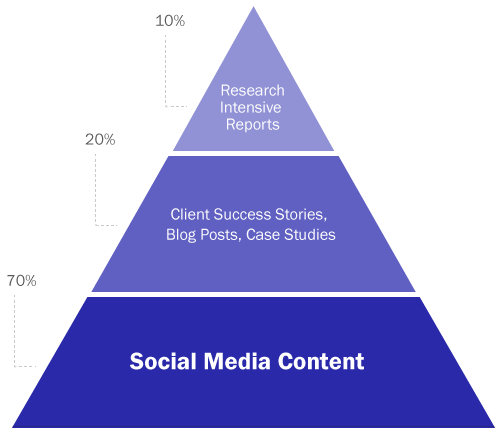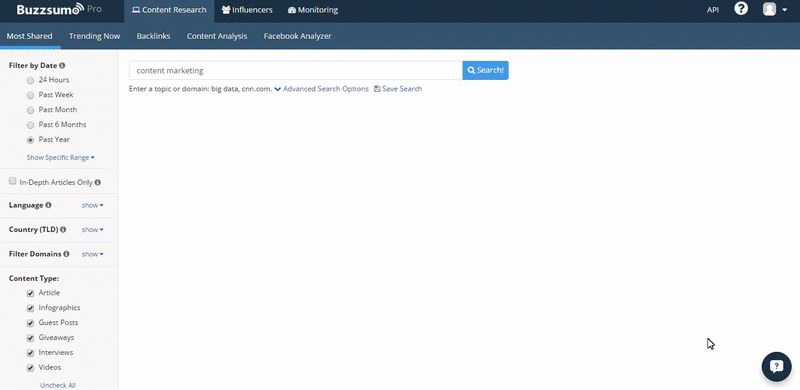As with most undertakings, before you begin writing or otherwise creating content, you should ask yourself some stock questions: why, what, when, and where—the 4Ws of content creation.
And because creating marketing content is as much science as it is art, the most powerful weapon you have at your disposal is data.
So, before you start working on your next piece of content, consider the 4Ws. Also keep in mind how you can use data to resolve the concerns you should be addressing with each question.
1. Why write/create content
In marketing, visibility is key. After you develop a product or service that addresses a gap in the market, how do you reach your target audience?
Say, for instance, you are a pet-care startup in Houston. When a pet owner googles "dog-grooming Houston" and your website or blog does not come up in search results, you need to worry. You need to get the word out, and to do that you need content.
Your website or blog must remain active and fresh. Search engines rank pages with fresher and dynamic content higher. That doesn't mean you must continually create new content; updating older content is viewed as staying fresh in the eyes of Google.
Apart from SEO reasons, content can help present your brand as if it were a person with a voice customers can relate to. Want to see what the content of a relatable brand looks like? Just follow Innocent Drinks on Facebook.
All that to say... before you start working on a piece of content, ask yourself why—define the result you hope to achieve with your content.
In SEO terms, that purpose has to do with being found online for the product or service you offer. For example, when I look up "remodel my kitchen," this article is one of the top results. It addresses pain points and concerns.
So use Google Analytics data to determine which terms customers are searching for when they land on your website looking for answers to help resolve their "pain." Also conduct keyword research to see how well you're ranking for relevant search terms vs. your competitors.
That data will help you come up with answers for the why of creating a specific piece of content. That leads us to the next W.
2. What to write
Using the insights you get from Google Analytics and other keyword research, work toward creating content that features the keywords people search for.
Google's Keyword Planner will help you with keyword research. Using historical data, you can keep track of search volume. Predicted clicks and estimated conversions can be invaluable in creating an effective content strategy (and in justifying your budget).
Check BuzzSumo for articles that feature the relevant search terms to see what content works. BuzzSumo arranges content in the order of the number of shares it received on Social Media. This will give you a good idea of what kind of content works.
Analyze the performance of your brand pages and accounts on social media. By assessing which of your content works best there, you can deliver consistently. You should also benchmark your performance to know what type of content works best in your industry.
3. When to write/post/publish
You need to put out content as regularly as the kind of content and the platform you place it on demand. For instance, Twitter analytics tools can tell you whether you are being too spammy or you aren't posting as frequently as you should. You can also find out the time of the day that gets you most engagement.
If you were the social media manager of McDonalds, for example, you'd want to know how much engagement your Tweets fetch depending on the time of the day. Here's that info for the three-month period from June to August 2016:

Clearly, you get great levels of engagement between 9 PM and 12 AM. With this insight, you might decide to tweet more during that time and cut down on tweets between 12 PM and 3 PM.
Social media scheduling tools offered by platforms such as HubSpot, Hootsuite, and Buffer can all suggest the time of the day you get most engagement.
Also keep an eye out for "holidays" that are relevant to your industry. If you are a doughnut franchise and you miss out on Doughnut Day, you'll never forgive yourself.
(You should have a content calendar. It will give your content creation activities a basic structure that you can build on.)
Match organization and preparedness with readiness to deliver content when it is called for. Use data to see what content is gaining traction in your industry. You can also identify available opportunities—topics that haven't received much attention from your sector, but might yield you leads or sales.
Coordinate content with your sales team. You can create content that can be an asset in sales pitches and which translate to sales.
4. Where to write/post/publish
While planning content, create different types (see image below) that are tailor-made both for the different audiences you plan reach and for the media and platforms you plan to use.
For example, Twitter has a clear 140-character limit, but Facebook, LinkedIn, and Instagram all have mostly unstated conventions on how long descriptions and posts should be.
The tone and strategy you adopt should also be tailored to the medium you are going to use. For example, if you are promoting your product or service, it could be OK to talk it up on your website or blog. If you are writing a guest post, however, you should be addressing a broader topic (you can probably still mention your awesome product in passing).
Regarding content types, a three-tiered strategy pays off. Here's what a well-balanced content strategy might look like:

You can do resource- and research-intensive posts once a year. These can talk about the key competencies of your product and should be placed within your website. Client success stories, blog posts, etc. can be published multiple times every month. Social media content has to be much more frequent.
As with all marketing... monitor, monitor, monitor! Figure out what kind of content gets you the most engagement. Social media analytics can point you in the direction of the medium that works the best for you, as well. You can also discover social media networks that you aren't part of yet, but which your competitors are benefiting from.
Paid content amplification is gaining a lot of traction. It is best to decide which post to put money behind based on data. Use the promoted post detection feature offered by Facebook analytics tools to understand what you stand to gain from promotion. You can identify what benefit your competitors are getting out of promotion. This, considered along with the reach and engagement that you currently get, can help you decide whether you should promote content.
* * *
Content creation cannot be reduced to a formula; it is still part art, after all. There is definitely no one-size-fits-all solution. However, what is common to every solution to a content crisis is that data can help provide answers.
Data-driven creativity is all about making sure your content gets to the audience you have in mind—effectively.






